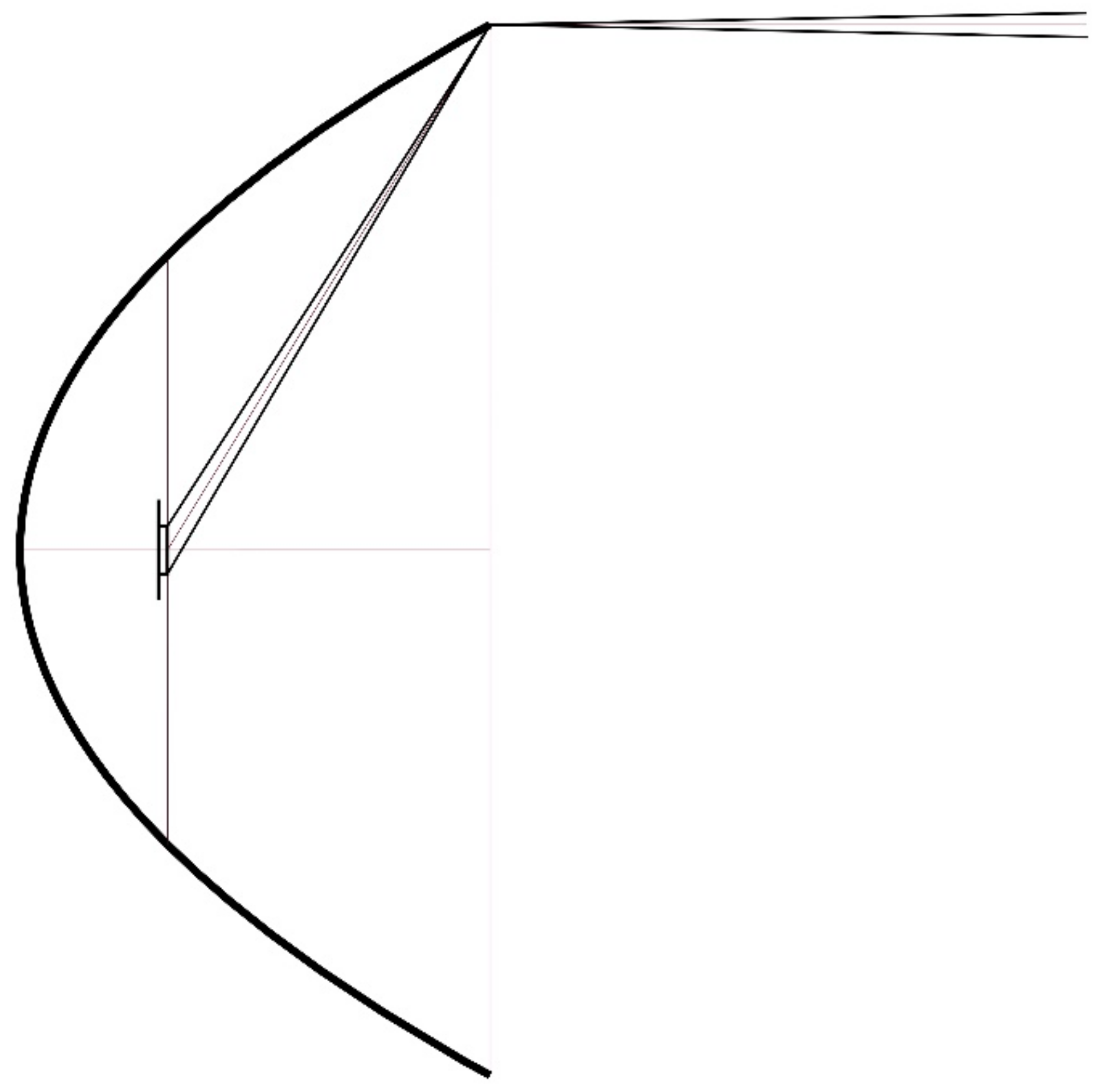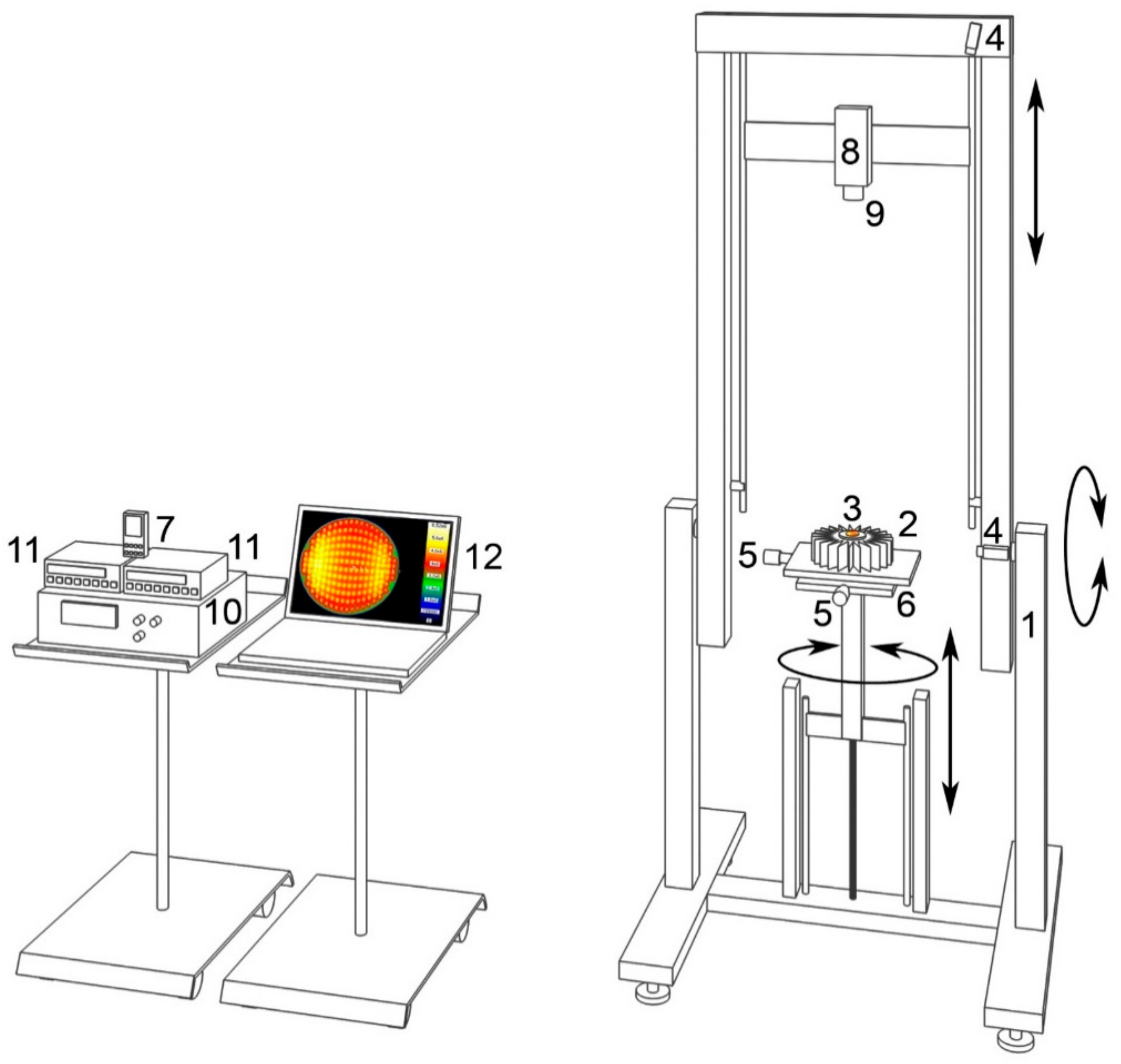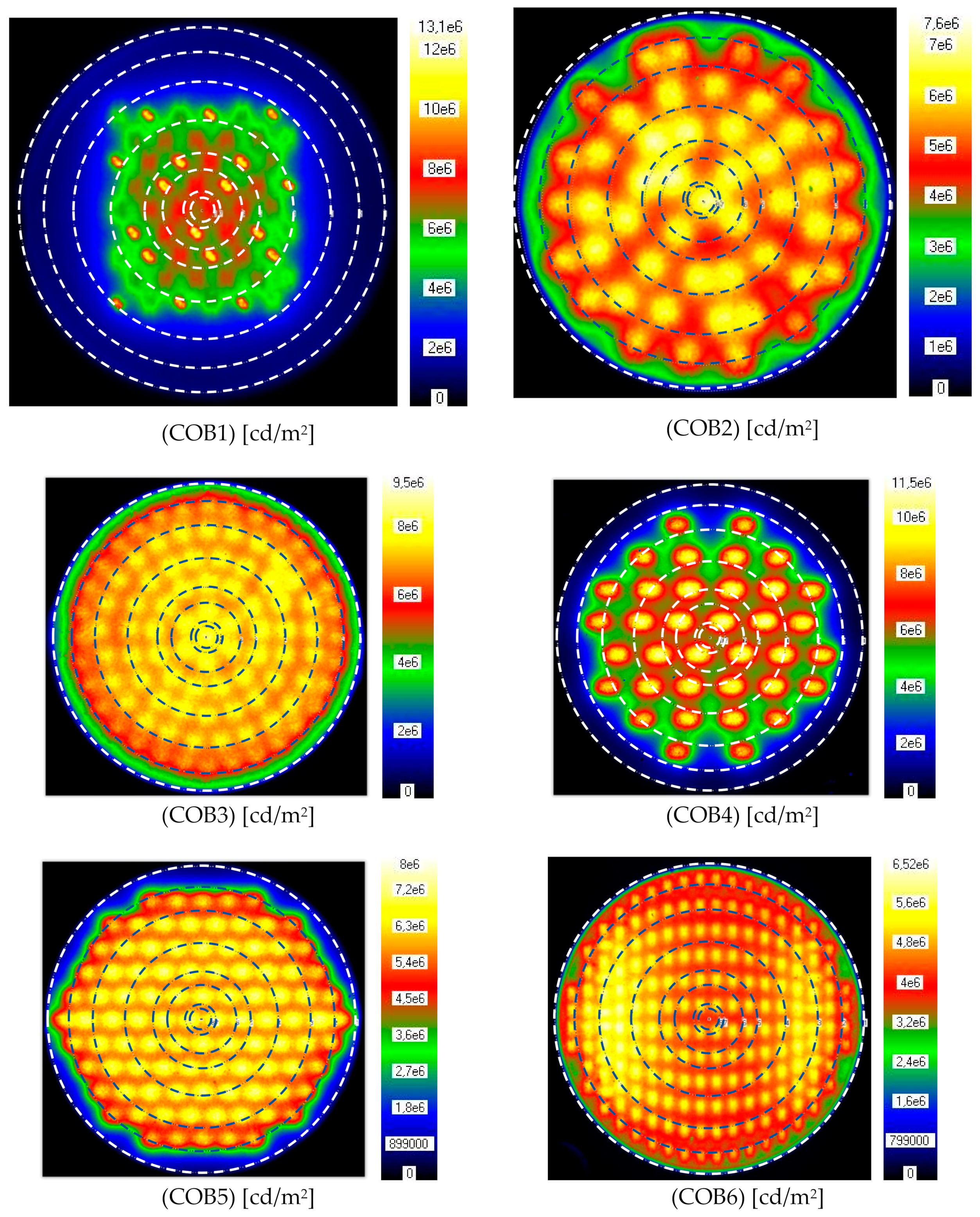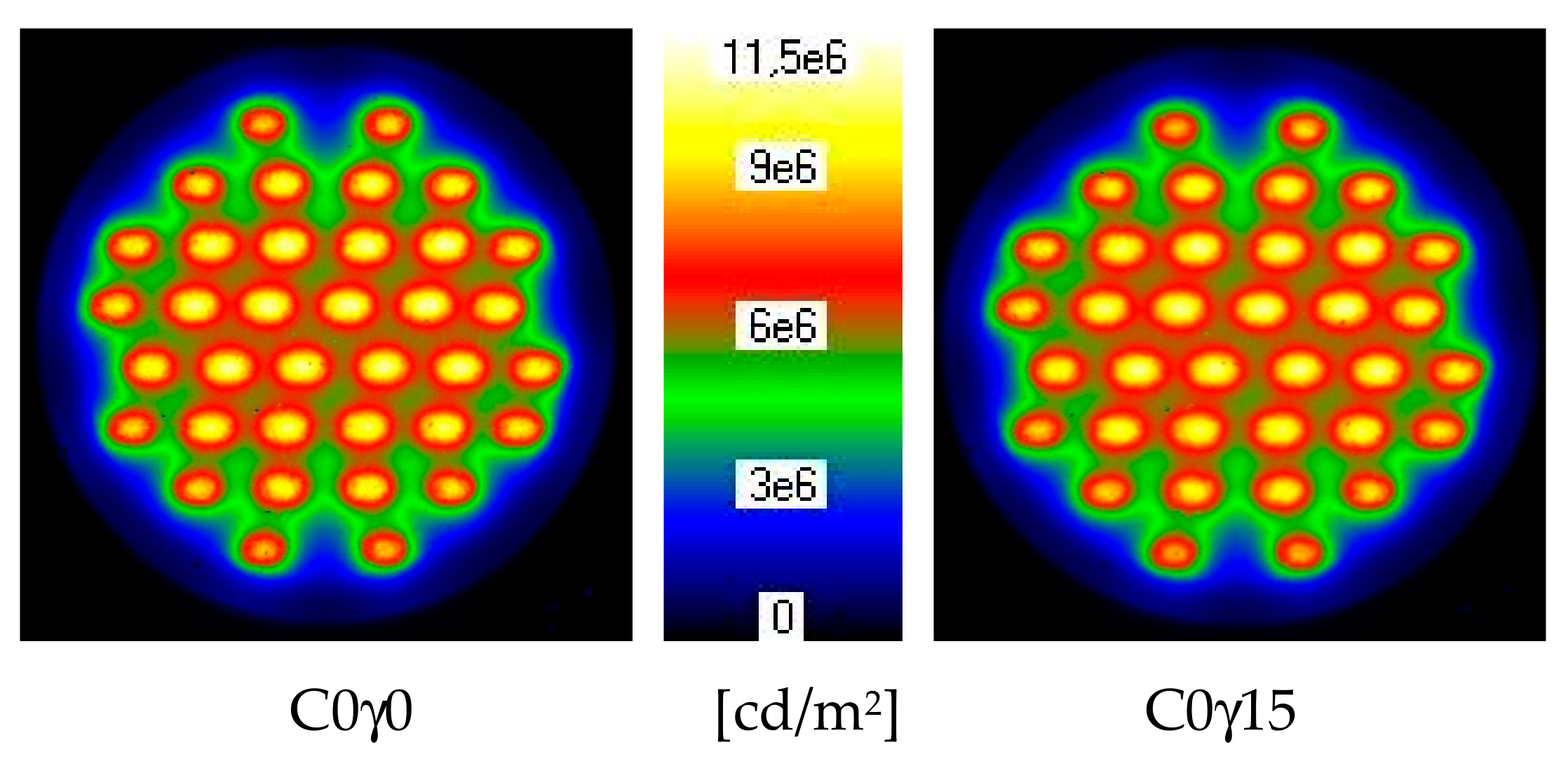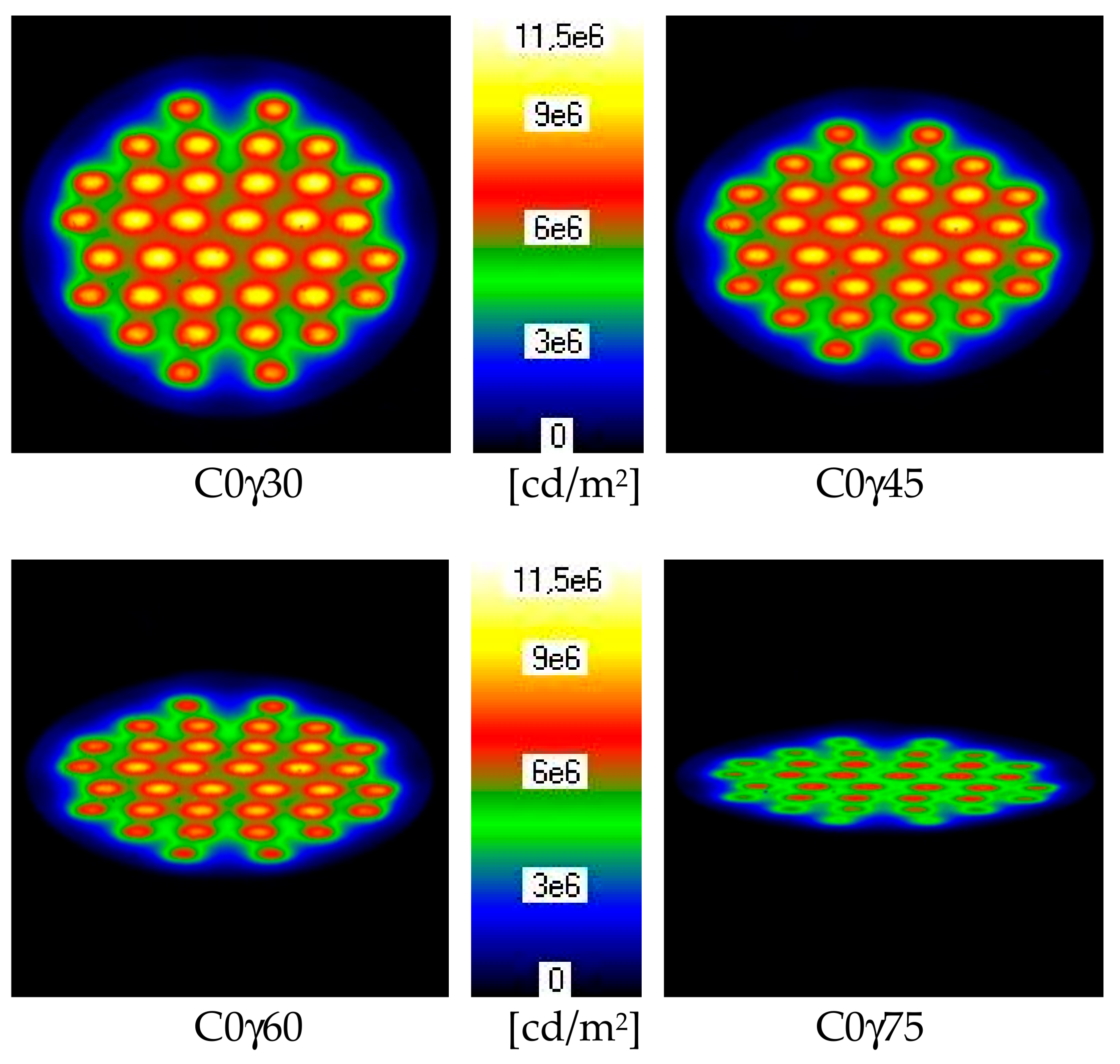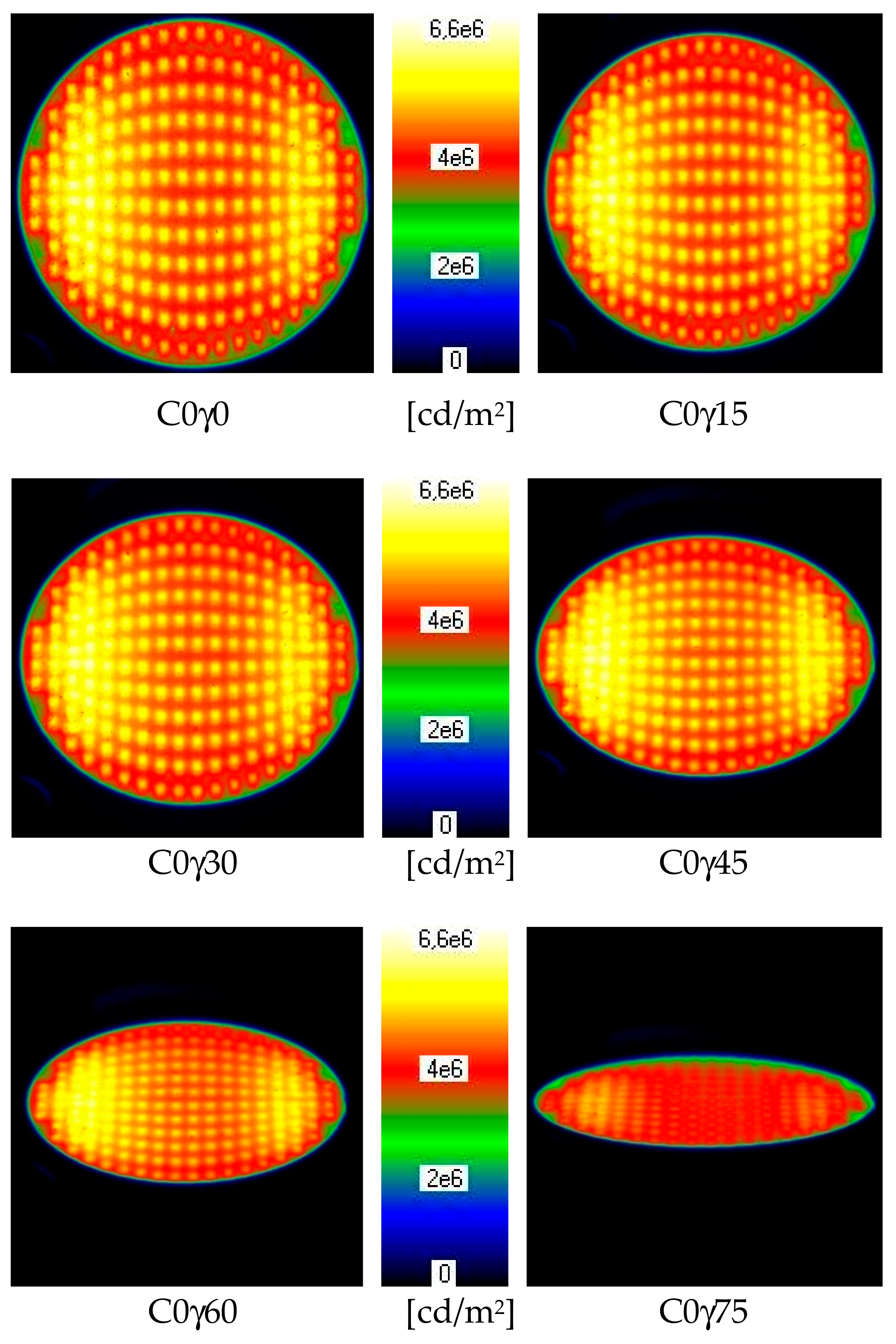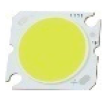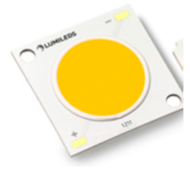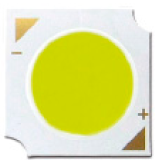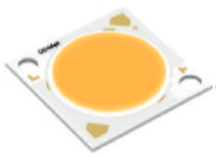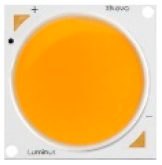1. Introduction
The producers of light-emitting diodes (LEDs) aim to create sources of light that will have as many diverse applications as possible. That is why there is a diversity of sizes, power, luminous efficacy (the effective one is nearly 200 lm/W and laboratory results are on the level of 300 lm/W [
1]), CCT-correlated color temperatures (usually from 2700 K and 6500 K), color rendering index (typically from 60 to 95) as well as long life (up to 100,000 h) [
2]. Nevertheless, despite high luminous efficacy, LEDs continue to have both low unit power and luminous flux. This fact has caused considerable limitations in terms of application where higher values of luminous flux were required (e.g. road lighting, stage lighting, floodlighting). LED matrixes are in particular frequently used in the construction of road lighting luminaires [
3,
4,
5,
6]. To deal with this problem, single LEDs have been put together into matrices with over 100 single LED chips each. Such a solution, however, resulted in a considerable decrease of the luminaire size and caused difficulty of heat dissipation emitted by the LEDs, as considerable heat flows of as much as 300 W/cm
2 or more occur on the matrix level [
7].
Moreover, the issue of glare phenomenon occurred, which is related to the high luminance of single LEDs [
8] and the way in which they were placed [
9,
10,
11,
12,
13]. Another functional aspect was the quality of color rendering by the light-emitting diodes. It turned out that the current method of establishing color rendering (Ra) was insufficient in the case of LEDs [
13]. Even though the document published by the International Commission on Illumination (CIE) in 1995 (CIE 13.3-1995) [
14] states that the color quality can be evaluated using the CRI Ra method for all light sources, multiple researches have shown the problem with the precision of white light color rendering by LEDs [
15,
16,
17]. In the latest document, CIE 224:2017 [
18], published by International Commission on Illumination (CIE), the Rf color fidelity indicator of light sources was identified, which is supposed to supplement the previous Color Rendering Index Ra (established in the 60 s also by CIE). Another topic discussed in the literature is the specific spectral distribution of light-emitting diodes which frequently entails exposing humans to blue light hazards [
19,
20], which affects melatonin suppression [
21,
22] and circadian rhythms [
23] and is a source of light pollution [
24,
25]. In addition, in LED displays, angular color shift and optical performance are closely related to the micro-LED sidewall emission [
26].
Recent research indicates that lead halide perovskite nanocrystals (PNCs) are the most promising candidates that can replace quantum-dots or phosphors in solid-state lighting (SSL) and liquid-crystal displays (LCD) backlight [
27]. The right phosphor composition can satisfy the demand for highly efficient, good color-rendering, and human-healthy SSL sources. [
28,
29].
Another development was the introduction of COB LEDs at the end of the 20th century. Thanks to this, it was possible to place a few micro-LEDs (as many as a few dozen on 1 cm
2 COB surface) on a small surface (up to a few cm
2). Thanks to such a solution and ongoing improvements of micro-chip luminous efficiency, COB LEDs obtain a luminous flux exceeding 20,000 lm. This significantly contributed to the development of new possible applications of LEDs. However, as the number and density of high-efficiency micro-chips grows in COB LEDs, the power of such light sources increases. Currently, with maximum program parameters, COB LEDs with powers exceeding as much as 300 W can be found on the market. This causes construction problems connected with the need to dissipate heat from a small surface, which is a serious issue for thermal system producers and constructors [
30,
31]. Moreover, the size of COB LED results in the need to use special, dedicated optical system constructions [
32,
33]. According to the latest research, limiting the Tj junction temperature is of key importance to the life of light-emitting diodes [
34]. Exceeding the maximum Tj junction temperature set by producers can irreversibly damage a LED [
35,
36].
For each optical system designer, knowing the luminance level and luminance distribution (including its gradient) on the light source surface is critical regardless of the type of light source used. In order to obtain high optical system amplification, it is best when the shape of the light source is similar to the light point and has high luminance. For paraboloidal systems, luminous flux angular density is the greatest (
Figure 1) with minimal divergence of luminous flux.
When the light source is not a point one, as in the case of COB LEDs, there is a divergence of the luminous flux reflected off the optical systems (e.g. paraboloidal reflector). The bigger the light source, the greater the divergence (
Figure 2). In this case, luminance distribution on the light source surface has a significant influence on the lighting manner. Other complex optical constructions influencing lighting uniformity in a positive manner have been documented in the literature [
37,
38].
It is worth mentioning that a small number of publications on lighting technology have been devoted to examining luminance distributions on LED surfaces [
8,
39,
40,
41,
42,
43] or LED luminance models [
44,
45], and even fewer have been devoted to research on COB LED luminance [
46].
The main objectives of the research were to establish luminance distribution on the surface of selected COB LEDs, to establish the luminance gradient, and to observe the dependence of luminance distribution on changing the observation direction. The additional goal was to determine the place where the maximum luminance occurs on the surface of examined light-emitting diodes.
3. Results
The first stage of the research was to determine and analyze luminance distribution from the optic axis direction. Moreover, changes in mean and maximum luminance were established for different areas marked on the examined COB LEDs. The areas marked for analysis were compliant with the COB LED shape and occupied respectively: 0.5%, 1%, 5%, 10%, 25%, 50%, 75% and 100% of the COB LED luminous surface, as shown in
Figure 4. The center of the marked areas was in the COB LED geometric center. Thanks to this analysis, it was possible to determine which area the maximum COB LED luminance was in. At the same time, it was determined whether this area was the smallest (among the analyzed ones) and closest to the diode’s geometric center, which is the most significant in terms of designing optical systems.
The next stage of the research was to examine luminance distributions on the COB LED surface for different observation directions in the (C,γ) system. C semi-planes were changed every 15° and γ angles every 5°.The results for C0 semi-plane and γ angles changed every 15° and were selected in order to present the research results clearly. The presentation of results for C0γ90 was abandoned, as for each angle, the light-emitting diodes did not shine (black image). For this reason, subsequent images present luminance distributions of specific COB LEDs (COB1, COB3 and COB6 were selected for presentation) for six observation directions: C0γ0, C0γ15, C030, C0γ45, C0γ60, and C0γ75.
Figure 5 presents luminance distributions on COB1 surface (350mA current) for different observation directions.
Figure 6 presents luminance distributions on the COB4 surface (720 mA current) for different observation directions.
Figure 7 presents luminance distributions on the COB6 surface (1280 mA current) for different observation directions.
4. Discussion
The first analyzed parameter was the way in which the micro-chip LED (micro-LED) was located on the COB LED surface. It was noted that on all examined COB LEDs, the arrangement of micro-LEDs was different. So, no standard in this respect was clearly visible. Moreover, it was observed that micro-LEDs were evenly placed in the cases of COB3, COB5 and COB6, while a certain irregularity was noted in the case of COB1 (
Figure 4). It was also noted that the manner in which micro-LEDs are arranged determines the luminance distribution on the COB LED surface. All the presented COB LEDs were circular in shape. However, the arrangement of micro-LEDs resulted in the dominant luminance, for example, COB5 were contained in the shape of a regular hexagon or in the case of COB1, in a square shape (
Figure 4). It was also noticed that the micro-LEDs create local luminance. This influences temperature distribution on COB LED surfaces. For example, in the case of COB3, the maximum luminance of one of the micro-LEDs in the COB center was 9.39 × 10
6 cd/m
2, and in the area on the COB edge on one of the micro-LEDs it dropped to 8.05 × 10
6 cd/m
2. The situation was similar with the remaining COB LEDs, with the exception of COB1 and COB6. In COB1, the micro-LEDs were arranged in the shape of a rectangle, and the maximum luminance in local maximums on the edge of the shape fluctuated from 5.25 × 10
6 cd/m
2 to 12.68 × 10
6 cd/m
2, i.e. closest to the highest luminance on the COB LED surface (13.06 × 10
6 cd/m
2).
The next stage of the research was to establish and analyze luminance distribution from the optical axis direction. For this purpose, the areas of analysis were marked on the examined COB LEDs, which corresponded to the shape of COB LEDs and occupied respectively: 0.5%, 1%, 5%, 10%, 25%, 50%, 75% and 100% of the COB LED luminous surface, as shown in
Figure 4. The results of the research for each area where the mean luminance, maximum luminance and minimum luminance were determined, are presented in
Table 3 and
Table 4.
On the basis of the conducted research, it can be concluded that the maximum luminance is not always located in the COB LED center or even in the area closest to the center (area no. 8). Only in the case of COB2 and COB3, the maximum luminance is located in the defined smallest area in the center of COB. In the remaining cases, the maximum luminance occurs outside the area closest to the center of the examined COB.
Moreover, it was concluded that the greater the test area, the smaller the mean luminance (for all COB LEDs (except COB6) for surfaces over 50%, areas no. 3, no. 2 and no. 1). This results from the previously mentioned method of micro-LED distribution and conditions of temperature distribution on COB LED surfaces. Due to the location of the local maximum luminance in the cases of COB4 and COB6, as the test area grows (from area no. 8 to area no. 1), the mean luminance at the beginning increases and then it decreases respectively for surfaces over 5% and 50% (respectively for COB4 and COB6).
The greatest disproportion between the maximum and mean luminance, measured for the entire COB LED surface (area no. 1), occurred for COB1, but it was also high for COB4. The maximum luminance was on COB1, which was over four times higher than the mean luminance (hence the greatest luminance gradient on COB1). The smallest luminance gradient was on COB3 and COB6 where the maximum luminance was 39% and 47% higher than the mean luminance (the smallest luminance gradient among the examined COB), as shown in
Figure 4.
The next stage of the analysis was determining the influence of changes of COB LED observation angle and luminance distribution on its surface. Analyzing the luminance distribution, it was concluded that mean luminance level varies along with the observation angle, which does not adhere to Lambert’s law. Light distribution in accordance with Lambert’s law is often discussed in the literature [
47,
48]. Generally, the spatial distribution of light is in accordance with Lambert’s law if the light changes according to the cosine function, and the luminance is constant for each direction of observation (distribution). This was not the case here.
As the observation angle changes (in (C, γ) system gamma angles from 0° to 90°), the mean luminance, minimum luminance and maximum luminance all decrease. The influence of observation angle on mean luminance is depicted in
Table 5, while the influence of the observation angle on maximum and minimum luminance is presented respectively in
Table 6 and
Table 7.
Analyzing the results of the conducted research, it was concluded that as the observation angle (γ) changes, the mean, maximum and minimum luminances also change. The mean luminance, for observation angle γ = 60° was on the level of over 90% of mean luminance obtained for angle γ = 0° (axial), where angle γ = 0° was treated as the point of reference. For angle γ = 75°, it was still on the level of 70% of the reference (axial) luminance. Moreover, it was observed that as the observation angle (γ) increases, the mean luminance usually decreases. However, for three COB LEDs, an increase in luminance was noted, i.e. the greatest value of mean luminance for COB 1 was for γ = 30° and γ = 45°, COB2 for γ = 15°, and COB6 for γ = 45°.
In the case of maximum luminance, the tendency of luminance to change as the observation angle increases is essentially similar to the mean luminance. For five COB LEDs, for angle γ = 45°, the maximum luminance was over 92% of the maximum luminance measured on the COB LED axis (for γ = 0°), except for COB1 where the maximum luminance was over 83% of the axial luminance. Practically, in all cases (except COB6), the maximum luminance decreased as the observation angle increased. For angle γ = 75°, the maximum luminance dropped to the level of approximately 70% of maximum luminance measured in the axis (except for COB1 where it dropped to 54%; the reason for this could have been a different construction and location of micro-LEDs). In the case of minimum luminance, a considerable influence of the measurement field marking precision on measurement results was noticed. However, the changes tendency, i.e. luminance dropped as the observation angle increased, was similar to mean and maximum luminance.
Moreover, as the observation angle increased, no considerable deformations of COB luminous surfaces were noticed. In earlier research, it was observed that deformation of the luminous surface occurs in the case of the LED with an additional (secondary) optical system, in particular in the case of Side Emitting (SE) LEDs.
As anticipated and following the theory, the size of the luminous surface changed in accordance with the cosinus function.
5. Conclusions
The increasingly bigger power of the produced COB LEDs, and as a result their bigger luminous flux, makes it possible for these light sources to be put to various uses. In practice, however, when buying COB LED, we only see a yellow surface, usually in the shape of a circle or a rectangle. Interestingly, circular COB was selected for the tests and only during the research it appeared that the micro-chips were not always arranged in a circle, but also in a hexagon (COB5) or a square (COB1). Moreover, no information about luminance distribution was found in light source catalogue data. It is the familiarity with the luminance distribution on COB LED surfaces that is a vital and essential piece of information in designing optical systems for such a light source.
In order to determine luminance distribution on COB surfaces, six COB LED pieces of a few well-known producers were chosen for the tests. Diodes of different sizes and micro-chip arrangements were selected for the tests. A great diversity in micro-chip arrangement and no standards in this respect were observed during the tests. A certain irregularity in micro-chip arrangement in one of the examined COB LEDs was noticed (COB1).
The following, among others, influence uniform luminance distribution on COB surfaces: the number of applied micro-LEDs, layout of micro-LEDs, micro-LEDs’ size, type and thickness of the used luminophore, and uniform distribution of the semiconductor’s structure temperature. Moreover, but to a lesser extent, in the case of COB LED, light emissions from micro LED’s side wall can also have some influence (however, luminophore partially limits this influence). On the basis of the conducted tests, it was concluded that one of the most uniform luminance distributions (the lowest gradient of change) occurred on COB6. The following factors contributed to this: A large number of used micro-LEDs and their uniform layout. The producer correctly selected the luminophore composition and provided uniform heat distribution in the semiconductor structures. It was noted that maximum luminance areas occurred in high micro-LED density areas or in places where heat transfer to the heat sink was the best and the local temperatures were the lowest (as in the case of COB6).
The conducted tests showed that all of the examined light sources have uneven luminance distribution. The greatest luminance gradient was on COB1 due to the rectangular arrangement of micro-chips on the circular surface. It was also observed that micro-LEDs create local luminance maximus. It was concluded that the greatest luminance occurs where the micro-chip density is the greatest and that the greatest luminance does not always occur in the COB LED center.
This is particularly important when designing optical systems as a designer needs to know where the maximum luminance occurs and take advantage of this fact.
If amplifying the system is crucial for the optical system designer, it will be desirable for the maximum luminance to be focused in the area of the light source center. If uniform lighting from the optical system is the designer’s priority, then COB LED should have the most uniform luminance distribution possible.
It was shown that as the COB LED observation angle changes, their mean and maximum luminance changes. The mean luminance for observation angle γ = 60° was on the level of over 90% of mean luminance for the axial angle. For even greater angles (up to γ = 75°), it remained on a high level (over 70% of axial luminance). It can therefore be concluded that COB LED, also for considerable observation angles, still remains a light source that can cause a discomfort glare. It was additionally concluded that there was no compliance of light emission from the COB LED surface with Lambert’s law.
The obtained results have led to the conclusion that designing optical systems for COB LED needs to consider irregular luminance distribution on their surface. The next stage of the research will be to determine the influence of unevenness of COB LED luminance distribution on the light distribution solid of the designed lighting fitting.

